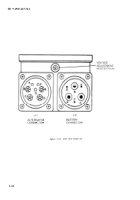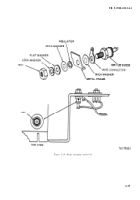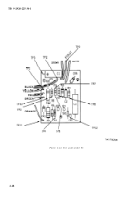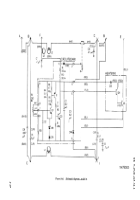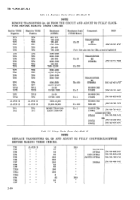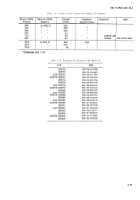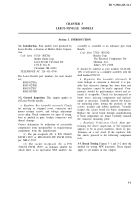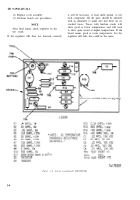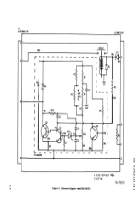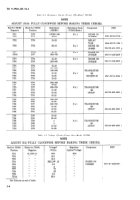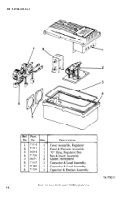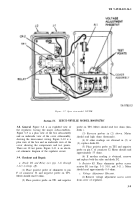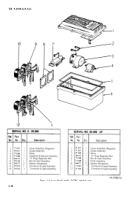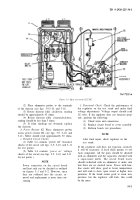TB-9-2920-225-34-1 - Page 40 of 70
TB 9-2920-225-34-1
Section II. LEECE-NEVILLE MODEL R0015027RA
3-4. General.
Figure 3–3 is a plan view of the
regulator with the cover removed, showing the
remaining test points. There are 10 total test
points. Figure 3–5 is an electrical schematic
diagram of the regulator circuit.
3-5. Checkout and Repair.
a. Diode D2 and Relay (see fig.
3–3
and
3–5)
(voltage off).
(1) Place positive probe of ohmmeter to pin
F of connector J2 and negative probe on TP1.
Meter should read 0 ohms.
(2) Place positive probe on TP1 and nega-
tive probe on TP2. Meter should read low ohms
(hundreds).
(3) Reverse probes in (2) above. Meter
should read high ohms (thousands).
(4) If other readings are obtained in (2)
or (3) above, replace diode D1.
(5) Place positive probe on TP2 and nega-
tive probe on Pin C of connector J2. Meter should
read approximately 55 ohms.
(6) If another reading is obtained, remove
and replace both the relay and diode D2.
b. Resistor R1.
Replace ohmmeter probe across
resistor R1 (see figs. 3-3 and 3-5). Meter should
read approximately 0.4 ohms.
c. Voltage Adjustment Rheostat (R15).
(1) Remove voltage adjustment access screw
from the cover of regulator.
(2) Place ohmmeter probes to terminals of
the rheostat (see figs. 3-4 and 3-5).
(3) Rotate rheostat fully clockwise; read-
ing should be approximately 45 ohms.
(4) Rotate rheostat fully counterclockwise;
reading should be less than 5 ohms.
(5) If other readings are obtained, replace
the rheostat, NSN 5905-00–581-1405.
d. Power Resistor R2.
Place ohmmeter probes
across power resistor R2 (see figs. 3-4 and 3–5).
Meter should read approximately 30 ohms.
e. Detailed Circuit Checks.
(1) Table 3–1 contains
“power off”
resist-
ance checks of the circuit (see figs. 3-3 and 3–4
for test points ).
(2) Table 3-2 contains
“power on”
voltage
checks of the circuit (see figs. 3–3 and 3-4 for
test points).
f. Functional Check.
Check the performance
of the regulator on the test stand and make final
voltage adjustments. Voltage output should read
28 volts. If the regulator does not function prop-
erly, perform the following:
(1) Check wires and connections.
Figure 3–3.
Top-view (Leece-Neville)–model R0015027RA.
3-3
Back to Top

